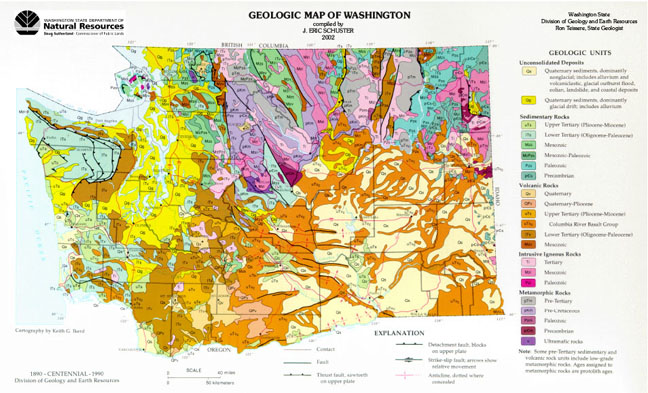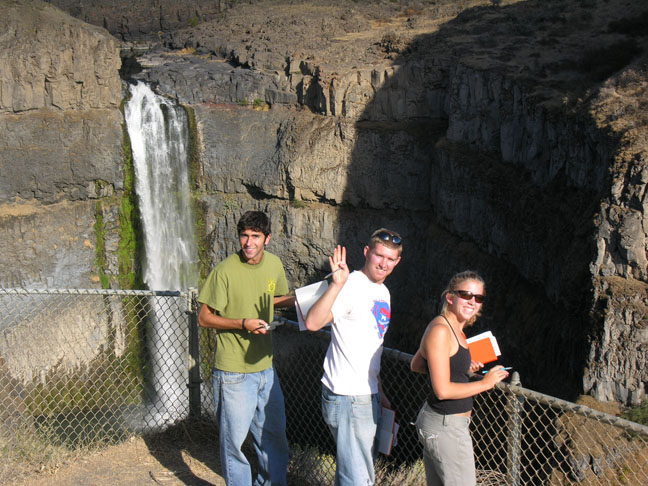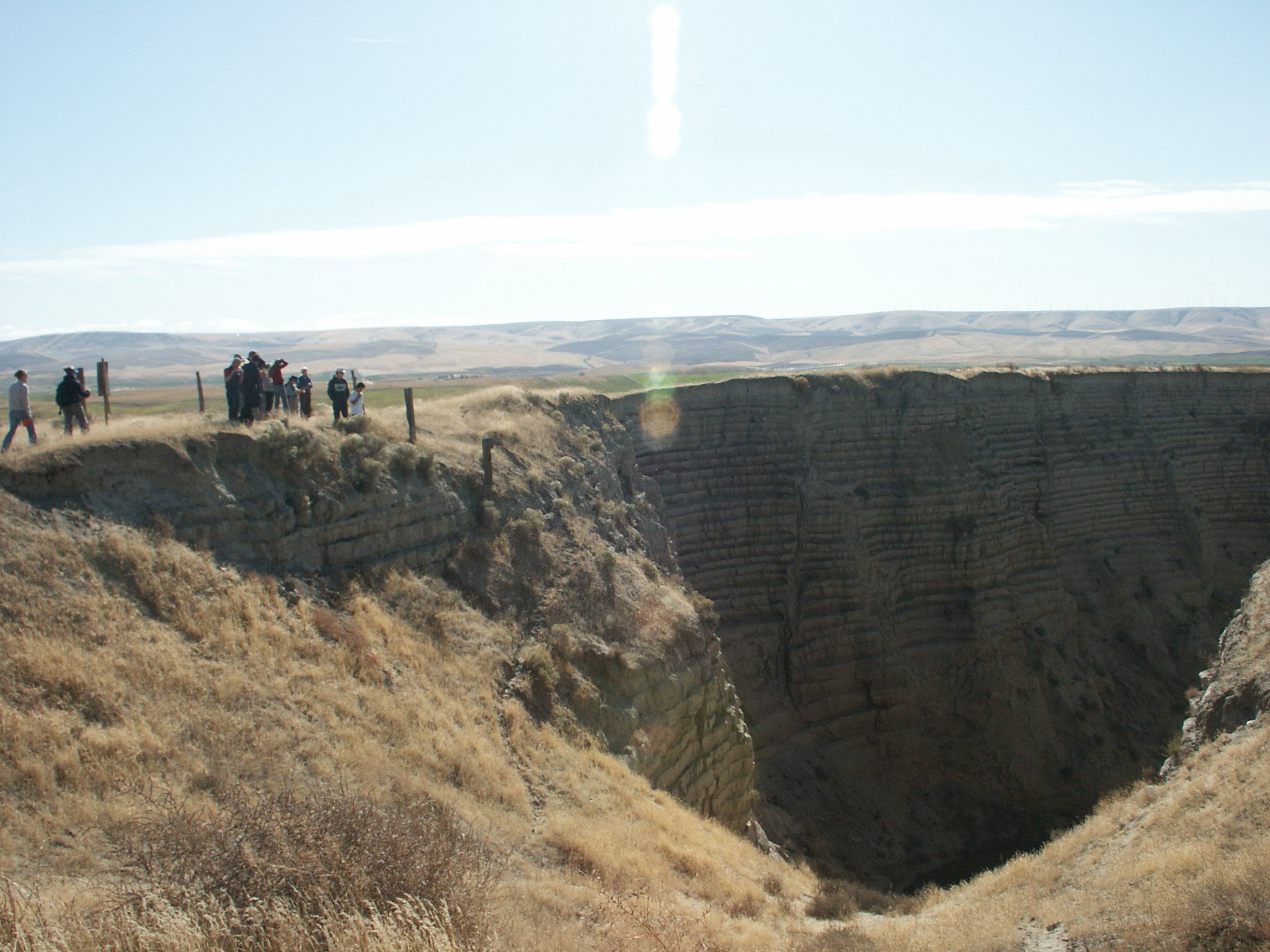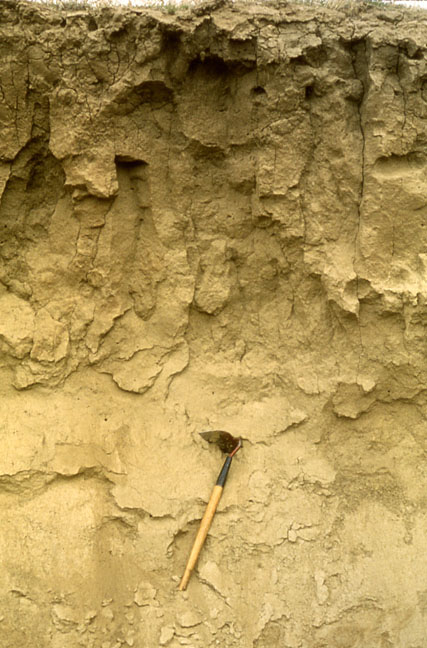General Geology of Southeastern Washington
by Bob Carson

Whitman College is situated on the eastern Columbia Plateau, site
of some of the most catastrophic events in earth history: enormous basaltic
lava flows 15 million years ago and giant jökulhlaups (glacier outburst
floods) 15 thousand years ago. These and related events shaped the landscape
of eastern Washington, where the Earth's youngest basalt plateau was
swept by the largest documented floods in geologic history.
-
The Columbia Plateau is a physiographic province,
part of a continent with somewhat similar rocks, landforms, soils,
climate, and vegetation. The rocks are mostly basalt; the landforms
are chiefly caused by erosion and deposition by jökulhlaups, but
also by  streams and the wind; the soils are thick on loess (windblown
silt) and immature to non-existent on sand, gravel, and basalt;
the climate is arid (with as little as 20 cm annual precipitation);
the natural vegetation is sagebrush shrubland and short-grass
prairie. streams and the wind; the soils are thick on loess (windblown
silt) and immature to non-existent on sand, gravel, and basalt;
the climate is arid (with as little as 20 cm annual precipitation);
the natural vegetation is sagebrush shrubland and short-grass
prairie.
-
The Columbia Plateau is bordered on the north and
east by the Rocky Mountains, the south by the Basin and Range
Province, and the west by the Cascades. The province is divided
into several physiographic sections: Whitman College is in the
southeastern part of the Walla Walla Plateau section, adjacent
to the northwest flank of the Blue Mountains section. On the Walla
Walla Plateau, two of the largest rivers in North America meet:
the Snake River which originates in Jackson Hole, Wyoming, and
the Columbia River which starts in the Columbia Icefields of the
Canadian Rockies.
-
In the Blue Mountains are a wide variety of Phanerozoic
rocks, predominantly late Paleozoic - early Mesozoic exotic terranes,
late Mesozoic granitic intrusives, and Tertiary volcanics. Most
of the Miocene basalt flows, which total as much as 3 km thick
in the Walla Walla Plateau section, originated in the Blue Mountains,
where there are long dikes.

Click on map to view or download from the Department
of Natural Resources |
Click on map to view or download from Department of Natural Resources
-
The Columbia River Basalt Group covers an area of about
2 x 105 km2 and has an estimated volume of 2 x 106 km3 (Swanson and
Wright, 1978). More than 99% of the basalt was erupted between 16.5
-14 m.y. ago. Eruptions occurred less often between 14 and 6 x 106
years B.P. Concurrent with volcanism were subsidence (e.g., the Pasco
Basin), deformation (e.g., the Yakima fold belt), erosion by rivers
(many of the valleys were later filled by intracanyon flows), and
sedimentation (e.g., the Ellensburg Formation). The north-south oriented
compressional stress regime of south-central Washington has existed
from the Miocene to present. Some anticlines in the Yakima fold belt
have developed as much as 1000 m of structural relief in the past
10 m.y. (Reidel et al., 1992).
-
The major tectonic element in southeastern Washington
is the northwest-trending Olympic-Wallowa lineament (OWL). It
is in part a strike-slip fault, and is aligned with many of the
anticlines of the Yakima fold belt (Tolan and Reidel, 1989). Most
of the  Yakima fold belt structures plunge to the east and die
out in central Washington, but the Horse Heaven Hills anticline
continues east across southern Washington and intersects the larger
Blue Mountains anticline in northern Oregon. Between the Columbia
River and the Blue Mountains, the OWL is formed by a 200-m high
escarpment that marks the trace of the Wallula fault zone, a series
of high-angle en echelon faults that display evidence for both
dip-slip and strike-slip motion. Yakima fold belt structures plunge to the east and die
out in central Washington, but the Horse Heaven Hills anticline
continues east across southern Washington and intersects the larger
Blue Mountains anticline in northern Oregon. Between the Columbia
River and the Blue Mountains, the OWL is formed by a 200-m high
escarpment that marks the trace of the Wallula fault zone, a series
of high-angle en echelon faults that display evidence for both
dip-slip and strike-slip motion.
-
The Hite fault intersects the Olympic-Wallowa lineament
at approximately a right angle 35 km southeast of Walla Walla.
This northeasterly-striking fault disappears near Lower Granite
Dam on the Snake River (Tolan and Reidel, 1989). The Walla Walla
area experienced an intensity VII (approximately magnitude 6)
earthquake on July 15, 1936 (Brown, 1937). The earthquake and
its aftershocks may have been caused by movement on the Wallula
fault zone and/or the Hite fault.
-
Although volcanism ceased on the Columbia Plateau,
tectonism continued, and the Quaternary brought a new group of
processes. In the Pasco Basin were many sources for wind-blown
detritus: the Miocene Ellensburg Formation, the Pliocene Ringold
Formation, and sediment deposited by the Columbia and Snake Rivers.
The sediment load of these rivers was augmented during the glaciations
of the Pleistocene; glaciers grew and shrank in the Cascades to
the west, British Columbia to the north, the Rockies to the east,
and the Wallowa and Elkhorn Mountains to the southeast. The prevailing
southwesterly winds transported silt from the Pasco Basin; the
silt became the thick loess in the Palouse Hills. Buried soils
in the Palouse Formation indicate that loess deposition was intermittent
during the Quaternary (Busacca, 1991).
-
The Cordilleran Ice Sheet originated in the mountains
of British Columbia and expanded southward into northern Washington,
Idaho, and Montana. Of particular significance to the landscape
of eastern Washington was a lobe of the Cordilleran Ice Sheet
which flowed along the Purcell Trench and blocked northwest-flowing
Clark Fork River near Cabinet Gorge on the Idaho-Montana border.  The ice dammed Glacial Lake Missoula (Pardee, 1910), which covered
7800 km2 of western Montana and held 2000 km2 of water; at the
ice dam the water was approximately 600 m deep (Weis and Newman,
1989). The ice dam failed repeatedly, releasing jökulhlaups which
swept across northern Idaho, through Spokane, southwestward across
eastern Washington, through the Columbia River Gorge, and out
into the Pacific Ocean. In eastern Washington the floods created
the Channeled Scablands, an area of intense study by J Harlen
Bretz in the 1920s (Baker and Nummedal, 1978). The ice dammed Glacial Lake Missoula (Pardee, 1910), which covered
7800 km2 of western Montana and held 2000 km2 of water; at the
ice dam the water was approximately 600 m deep (Weis and Newman,
1989). The ice dam failed repeatedly, releasing jökulhlaups which
swept across northern Idaho, through Spokane, southwestward across
eastern Washington, through the Columbia River Gorge, and out
into the Pacific Ocean. In eastern Washington the floods created
the Channeled Scablands, an area of intense study by J Harlen
Bretz in the 1920s (Baker and Nummedal, 1978).
-
In
general where water velocities were highest the Missoula floods eroded
channels, many with scour depressions, and left scabs or erosion remnants
of basalt - hence the name Channeled Scablands for eastern Washington.
Where the floods slowed down a little, such as in eddies, giant gravel
bars were deposited; the Pasco gravels were transported as bed load
and contain many lithologies that are not Columbia River basalts.
Where the floods ponded, for example in the Walla Walla Valley, relatively
fine-grained slackwater sediments were deposited (Bretz, 1928); these
graded rhythmites are called the Touchet beds (Flint, 1938). Large
icebergs rode the jökulhlaups and left erratic boulders along the
main route of the floods and far up tributary valleys.
-

Waitt (1980) argued that each of about 40 Touchet beds
resulted from a separate catastrophic flood. These floods could only
occur when glacial Lake Missoula existed, which Waitt (1985) estimates
at 15,300 to 12,700 years B.P. Mt. St. Helens "S" ash fell in eastern
Washington about 13,000 years B.P. and is ten rhythmites below the
top of the Touchet beds (Waitt, 1980). After each jökulhlaup swept
through Spokane, much of the floodwater dumped into Glacial Lake Columbia
at the northern edge of the Columbia Plateau (Atwater, 1984). This
lake formed when the Columbia River was blocked at the present site
of Grand Coulee Dam by the Okanogan Lobe of the Cordilleran Ice Sheet.
Atwater (1984) counted flood deposits and varves which accumulated
in Glacial Lake Columbia and determined that the interval between
Missoula floods was 35 to 55 years.
-

During the Holocene, the collapse of Mt. Mazama
about 6845 years B.P. to form Crater Lake showered southeastern
Washington with Mazama tephra (Bacon, 1983). About a meter of
loess blanketed the area, and dunes migrated downwind from major
rivers until modern dams made reservoirs that drowned the sand
supply. Intense agricultural activity has resulted in extreme
erosion of the fine-grained soils.
-
References Cited
Atwater, B.F., 1984, Periodic floods from glacial Lake Missoula into
the Sanpoil arm of glacial Lake Columbia, northeastern Washington:
Geology, v. 12, p. 464-467.
Bacon, C.R., 1983, Eruptive history of Mount Mazama
and Crater Lake caldera, Cascade Range, U.S.A.: Journal of Volcanology
and Geothermal Research, v. 18, p. 57-115.
Baker, V.R., and Dag Nummedal, eds., 1978, The Channeled
Scabland (a guide to the geomorphology of the Columbia Basin,
Washington): National Aeronautics and Space Administration, 186
p.
Busacca, A. J., 1991, Loess deposits and soils
of the Palouse and vicinity, in V. R. Baker, B. N. Bjornstad,
and others, Quaternary geology of the Columbia Plateau, in R.
B. Morrison, ed., Quaternary nonglacial geology - conterminous
U.S.: Geol. Soc. America DNAG Geology of North America, v. K-2,
p. 216-228.
Bretz, J H., 1928, Alternative hypotheses for Channeled
Scabland I, II: Journal of Geology, v. 36, p. 193-223, 312-341.
Brown, B.H., 1937, The State-Line earthquake at
Milton and Walla Walla: Seismol. Soc. Am. Bull., v. 237, p. 205-209.
Carson, R.J., ed., 2008, Where the great river bends: A natural and human
history of the Columbia at Wallula:
Sandpoint, Idaho: Keokee Books, p. 220.
Carson, R.J., and K.R. Pogue, 1996, Flood basalts and glacier floods: Roadside
geology of parts of Walla Walla,
Franklin, and Columbia Counties, Washington: Washington Division of Geology and
Earth Resources
Information Circular 90, p. 47.
Carson, R.J., and S. Babcock, 2009, Hiking guide to Washington geology:
Sandpoint, ID, Keokee Books
(reprint of Babcock and Carson, 2000).
Flint, R.F., 1938, Origin of the Cheney-Palouse
Scabland Tract, Washington: Bull. Geol. Soc. America, v. 49, p.
461-524.
Pardee, J.T., 1910, The Glacial Lake Missoula:
Journal of Geology, v. 18, p. 376-386.
Reidel, S.P., K.R. Fecht, and K.A. Lindsey, 1992,
Post-Columbia River basalt structure and stratigraphy of south-central
Washington: Geol. Soc. America Abstracts with Programs, v. 24,
no. 5, p. 78.
Swanson, D.A., and T.L. Wright, 1978, Bedrock geology
of the northern Columbia Plateau and adjacent areas, in V.R. Baker
and Dag Nummedal, eds., the Channeled Scabland (a guide to the
geomorphology of the Columbia Basin, Washington): National Aeornautics
and Space Administration, p. 37-57.
Tolan, T.L., and S.P. Reidel, 1989, Structure map
of a portion of the Columbia River flood-basalt province, in S.P.
Reidel and P.R. Hooper, eds., Volcanism and tectonism in the Columbia
River flood-basalt province: Geol. Soc. America Special Paper
239.
Waitt, R.B., 1980, About forty last-glacial Lake
Missoula jökulhlaups through southern Washington: Jour. Geology,
v. 88, p. 653-679.
Waitt, R.B., 1985, Case for periodic, colossal
jökulhlaups from Pleistocene glacial Lake Missoula: Geol. Soc.
America Bull., v. 96, p. 1271-1286.
Weis, P.L., and W.L. Newman, 1989, The Channeled
Scablands of eastern Washington - The geologic story of the Spokane
Flood: Eastern Washington University Press, Cheney, 25 p.
|


 streams and the wind; the soils are thick on loess (windblown
silt) and immature to non-existent on sand, gravel, and basalt;
the climate is arid (with as little as 20 cm annual precipitation);
the natural vegetation is sagebrush shrubland and short-grass
prairie.
streams and the wind; the soils are thick on loess (windblown
silt) and immature to non-existent on sand, gravel, and basalt;
the climate is arid (with as little as 20 cm annual precipitation);
the natural vegetation is sagebrush shrubland and short-grass
prairie.

 Yakima fold belt structures plunge to the east and die
out in central Washington, but the Horse Heaven Hills anticline
continues east across southern Washington and intersects the larger
Blue Mountains anticline in northern Oregon. Between the Columbia
River and the Blue Mountains, the OWL is formed by a 200-m high
escarpment that marks the trace of the Wallula fault zone, a series
of high-angle en echelon faults that display evidence for both
dip-slip and strike-slip motion.
Yakima fold belt structures plunge to the east and die
out in central Washington, but the Horse Heaven Hills anticline
continues east across southern Washington and intersects the larger
Blue Mountains anticline in northern Oregon. Between the Columbia
River and the Blue Mountains, the OWL is formed by a 200-m high
escarpment that marks the trace of the Wallula fault zone, a series
of high-angle en echelon faults that display evidence for both
dip-slip and strike-slip motion.
 The ice dammed Glacial Lake Missoula (Pardee, 1910), which covered
7800 km2 of western Montana and held 2000 km2 of water; at the
ice dam the water was approximately 600 m deep (Weis and Newman,
1989). The ice dam failed repeatedly, releasing jökulhlaups which
swept across northern Idaho, through Spokane, southwestward across
eastern Washington, through the Columbia River Gorge, and out
into the Pacific Ocean. In eastern Washington the floods created
the Channeled Scablands, an area of intense study by J Harlen
Bretz in the 1920s (Baker and Nummedal, 1978).
The ice dammed Glacial Lake Missoula (Pardee, 1910), which covered
7800 km2 of western Montana and held 2000 km2 of water; at the
ice dam the water was approximately 600 m deep (Weis and Newman,
1989). The ice dam failed repeatedly, releasing jökulhlaups which
swept across northern Idaho, through Spokane, southwestward across
eastern Washington, through the Columbia River Gorge, and out
into the Pacific Ocean. In eastern Washington the floods created
the Channeled Scablands, an area of intense study by J Harlen
Bretz in the 1920s (Baker and Nummedal, 1978).

